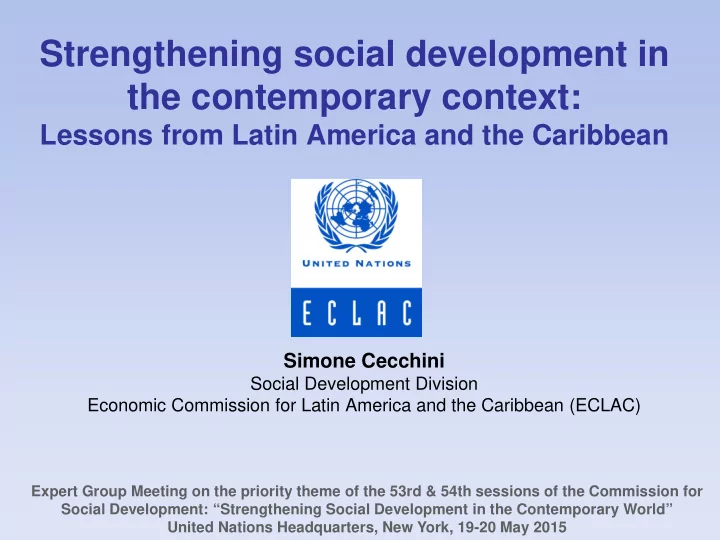

Strengthening social development in the contemporary context: Lessons from Latin America and the Caribbean Simone Cecchini Social Development Division Economic Commission for Latin America and the Caribbean (ECLAC) Expert Group Meeting on the priority theme of the 53rd & 54th sessions of the Commission for Social Development: “Strengthening Social Development in the Contemporary World” United Nations Headquarters, New York, 19-20 May 2015
From residual social policies to the expansion of social protection Structural adjustment model Current trends • Downscaling of State action • Broadening social expenditure • Central role of markets in • The State has a regulating role allocating goods and services to face market asymmetries • Social transfers based on • Integral policies to face poverty: emergency criteria expanding assets and capabilities • Social protection based on labour (male-breadwinner • Social protection in a difficult model) labour scenario: from the contributive to the solidarity • Informal mechanisms: pillar lobbying and favouring • Towards a covenant based on social rights
Expansion of social public expenditure over the last 20 years PUBLIC EXPENDITURE ON SOCIAL SECURITY AND ASSISTANCE, EDUCATION AND HEALTH AS A PERCENTAGE OF GDP, 1992-1993 TO 2012-2013 Source: Economic Commission for Latin America and the Caribbean (ECLAC), Social Expenditure Database.
Social protection coverage has increased PERSONS 65 YEARS AND OLDER WHO RECEIVE COVERAGE OF CONDITIONAL CASH TRANSFER PENSIONS, 2002 AND 2011 (PERCENTAGES) PROGRAMMES, 2000-2013 (PERCENTAGES OF TOTAL POPULATION) 43 41.9 42 41 40 39 38 37.0 37 36 35 34 2002 2011 EMPLOYED POPULATION AFFILIATED TO SOCIAL SECURITY, 2002 AND 2011 (PERCENTAGES) 70 66.4 60 55.4 54.4 46.1 50 40 30 Source: Economic Commission for Latin America and the Caribbean 20 (ECLAC), database on non- 10 contributory social protection programmes in Latin America and 0 Pension Health the Caribbean, and Social Panorama of Latin America 2013. 2002 2011
The rights-based approach: from programmes to policies, from emergency to entitlements • Shift from needs-based social policies to policies based on social rights has been a key turning point in LAC • The State has primary responsibility to promote ESCRs • Challenge: moving from rhetoric to practice • Some examples: Unified Health System & Continuous Benefit Programme in Brazil; Explicit Health Guarantees in Chile; Universal Pension in the Federal District of Mexico
Rights-based approach and social guarantees in Latin America Country Constitutional recognition of social rights Rights-based approach in social protection Explicit guarantees Argentina Yes Yes Bolivia (Plurinational State of) Yes Yes Yes Brazil Yes Yes Yes Chile Yes Yes Colombia Yes Yes Yes Costa Rica Yes Yes Cuba Yes Yes Ecuador Yes Yes El Salvador Yes Yes Guatemala Yes Yes Honduras Yes Mexico Yes Yes Nicaragua Yes Panama Paraguay Yes Yes Peru Yes Yes Dominican Republic Yes Uruguay Yes Yes Venezuela (Bolivarian Rep. of) Yes Yes Source: Cecchini and Martínez (2011) and Cecchini and Vargas (2014).
Strengthening of social development institutions • Integral view of social policy entails growing complexity and need for coordination – Demand-side (life cycle & social groups) and supply-side (vertical & sectoral) dimensions of integration • Creation of social development ministries and social cabinets • Comprehensive policies and programmes – Brazil: Bolsa família & Brasil sem Miséria ; Chile: Chile Solidario • Social policy management progress and challenges – Information systems; monitoring and evaluation; coordination at the local level
Reduction of poverty and inequality LATIN AMERICA: POVERTY AND EXTREME POVERTY RATES, 2002-2014 50 Poverty Extreme poverty 43.9 45 40 33.5 35 29.6 28.1 28.1 28.0 30 25 19.3 20 12.9 12.0 15 11.6 11.7 11.3 10 5 0 2002 2008 2011 2012 2013 2014 a LATIN AMERICA: GINI COEFFICIENTS, 2002 AND 2013 Source: Economic Commission for Latin America and the Caribbean (ECLAC), Social Panorama of Latin America 2014.
Persistence of structural development problems and challenges to public policies • Heterogeneity of productive structure is reproduced in labour markets (informality) and transmitted to the entire society (inequality) • Channels: distribution of profits and stratified access to contributory social protection for workers • Quality of social services (education, health) • Prevention and response to natural disasters
Facing a complex economic and political context • Lower economic growth (1.0% in 2015) • Social investment no longer growing • Poverty reduction process stalled • Continuing demands to increase coverage and improve quality of publicly-provided social services • Establish fiscal and social protection covenants • Most States are in a condition to collect greater amounts of fiscal resources
Recommend
More recommend